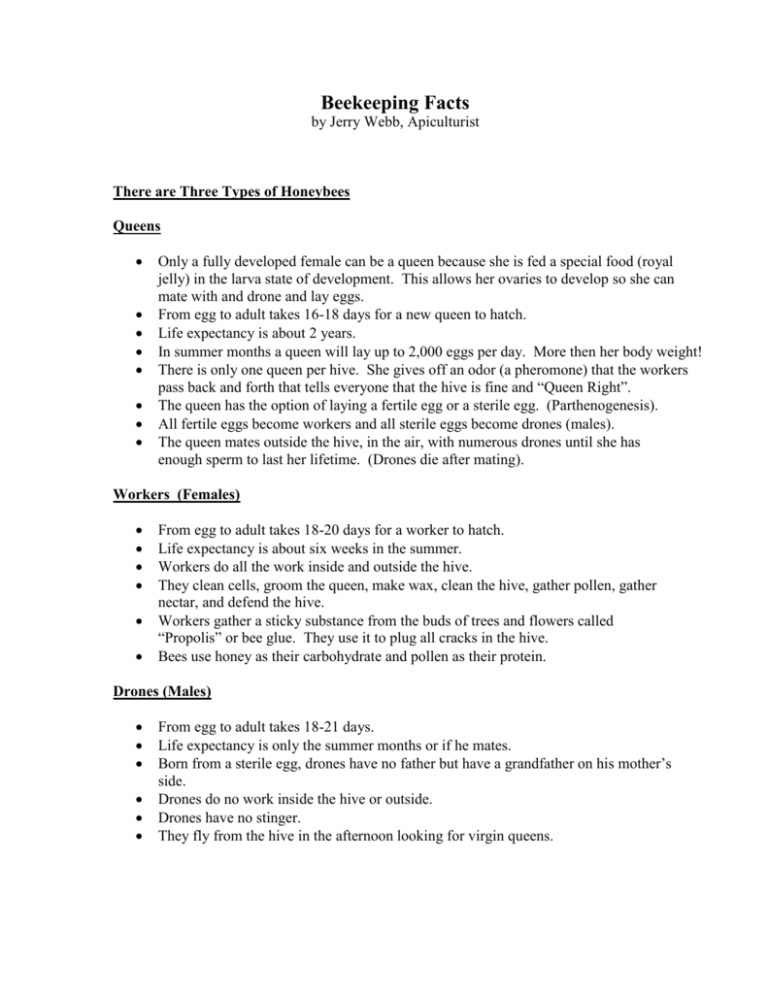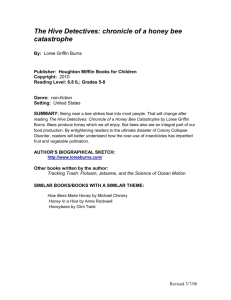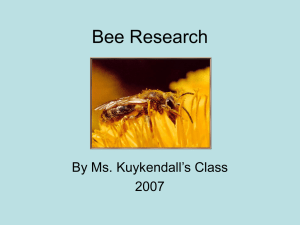Beekeeping Facts by Jerry Webb
advertisement

Beekeeping Facts by Jerry Webb, Apiculturist There are Three Types of Honeybees Queens Only a fully developed female can be a queen because she is fed a special food (royal jelly) in the larva state of development. This allows her ovaries to develop so she can mate with and drone and lay eggs. From egg to adult takes 16-18 days for a new queen to hatch. Life expectancy is about 2 years. In summer months a queen will lay up to 2,000 eggs per day. More then her body weight! There is only one queen per hive. She gives off an odor (a pheromone) that the workers pass back and forth that tells everyone that the hive is fine and “Queen Right”. The queen has the option of laying a fertile egg or a sterile egg. (Parthenogenesis). All fertile eggs become workers and all sterile eggs become drones (males). The queen mates outside the hive, in the air, with numerous drones until she has enough sperm to last her lifetime. (Drones die after mating). Workers (Females) From egg to adult takes 18-20 days for a worker to hatch. Life expectancy is about six weeks in the summer. Workers do all the work inside and outside the hive. They clean cells, groom the queen, make wax, clean the hive, gather pollen, gather nectar, and defend the hive. Workers gather a sticky substance from the buds of trees and flowers called “Propolis” or bee glue. They use it to plug all cracks in the hive. Bees use honey as their carbohydrate and pollen as their protein. Drones (Males) From egg to adult takes 18-21 days. Life expectancy is only the summer months or if he mates. Born from a sterile egg, drones have no father but have a grandfather on his mother’s side. Drones do no work inside the hive or outside. Drones have no stinger. They fly from the hive in the afternoon looking for virgin queens. Honey Honey is the oldest sweetener known to mankind. Bees gather nectar from the flowers, inject enzymes into it and change the sugar composition. Workers bring it back to the hive and evaporate the water from it and cap it with beeswax. Honey is 100 calories per teaspoon. The oldest alcoholic beverage known to man is Mead. It is made from fermented honey. In ancient times, when a couple got married, they went away for one full moon, (30 days), and drank Mead. That’s where the word “honeymoon” came from. To get honey for our table, the beekeeper slices the wax cappings from the combs of honey and then puts the frames into a spinner that throws the honey from the comb. The honey is then filtered and bottled. When America was discovered, there were no honeybees here. Honeybees were brought here from Europe and the bees we see around here are three-banded Italian honeybees. Most of the flowering trees, shrubs, and plants we have were also brought from Europe and needed honeybees to pollinate them. American Indians called the bee the “White Man’s Fly”. The first documentation of honeybees in North America finds them in Virginia in 1622. By 1792, swarms had crossed the Mississippi River and by 1809 bee trees were found 600 miles up the Missouri River. Isaac McBroom transported the first colony across the plains to Colorado by ox cart in the summer of 1862. The bees did not survive the first winter. In 1863, F. J. McQuiston was successful and by 1880 there were over 260 colonies of bees in Colorado. By 1900, there were 85,000 colonies and today there are about 45,000 colonies. Bees are worth $240 million in agricultural production each year through pollination. This represents the third largest slice of Colorado’s agricultural pie. Bees can fly about 18 miles per hour. They can only sting once because the worker’s stinger has barbs on it and it cannot be retracted. The stinger is torn from her body before she dies. The best way to remove a stinger is to scrape it off then put ice on the sting. Honeybees rarely sting people. Usually stings come from wasps, yellow jackets or hornets. It is said that over 5,000 plants a year would be come extinct if it were not for the bee. Bees are worth 10 billion dollars each year to our national economy for their pollination services. A colony of bees can have up to 80,000 bees in the summer months. They can produce over 100 pounds of surplus honey each year. Bees cluster around their stored honey and eat it in the winter. A healthy colony can usually survive on their surplus honey stores until flowers bloom again. Swarming is what bees do to multiply. In the spring, when there is lots of food, the old queen (a proven layer), will leave the hive with about half the population and will look for a new home. When the bees leave, they all fill up with honey. When they are full, they are very gentle. They leave the hive and cluster on a branch, etc. and send out scouts looking for a hollow tree or a hole in a wall. They all move into their new location, digest the honey, and make wax and cells and the whole process starts over again. Beekeepers puff smoke on the bees to make them fill up with honey and then they are like you after eating a big meal, very gentle. Bees are the only creatures that do not kill or maim something to live. Enemies Bees have many enemies. Bears have become a big problem ever since a law was passed to prevent spring hunting. Beekeepers now have to use expensive electric fences to keep bears out. Skunks are sometimes a problem and a mite, (the Varroa Mite), is now in Colorado. The mites will kill any hive that is not treated. Man is the biggest problem with his sprays and destruction of pasture. The evidence is clear that without a beekeeper or bee tree within a mile or two, many common fruit and garden crops cannot be raised successfully. Many people have a hive or two in their backyards in Metro Denver. It’s a great hobby for parents and children to share. The hobby is great for the honey and the beeswax can be used to make the very best candles. The cost to start up two hives, along with the safety equipment, would run about $500.00. It is possible to recover your investment in the first year. Moisture = flowers = Honey. The only bee that man has to fear is the last one that man kills. Then everything stops. Jerry Webb, Apiarist 9684 W. Sunbeam Avenue Littleton, CO 80125 303-791-1777





